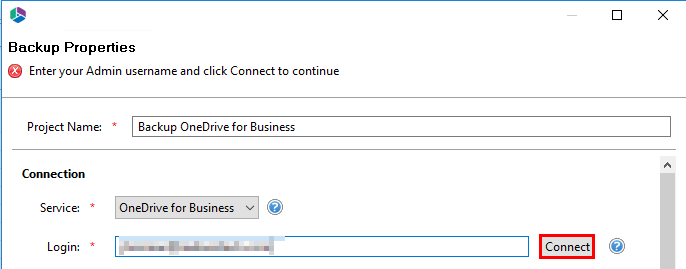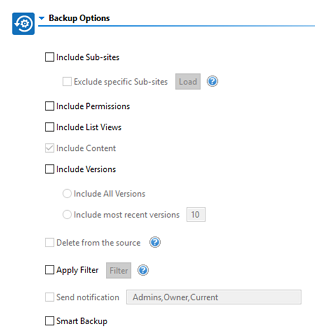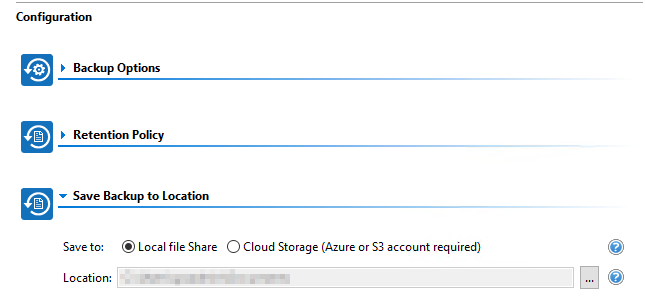Restoring Documents during an Item, List, or Site Operation
Documents can be restored in-place or documents can be restored out-of-place. If a document is restored to any location where a document with the same name already exists, the restore operation will overwrite/replace the current SharePoint document. If a document with that name does not exist, then it will be restored from the backup as a new document.
Restoring Non-Document list items during an item, list or site operation
When restoring a list item, the operation will create a new item in the selected location. This means that if the item already exists in this list, a second (or more) item will be created with potentially the same metadata.
Hyper OneDrive Backup
Metalogix Essentials for Office 365 Backup is a simple and easy to use backup tool that empowers administrators and power users to efficiently backup, archive, and restore their content from SharePoint, Office 365 SharePoint Online, OneDrive for Business sites, and Exchange Online mailboxes (when licensed). With Metalogix Backup, you can quickly retrieve individual items or entire sites.
·Site Backup: Backup and extract site collections, sites, lists and libraries, documents and versions, permissions, views, column groups, fields, terms, and content types in SharePoint or Office 365.
·OneDrive for Business Backup: Backup and extract content, versions and SharePoint permissions from one or more users' OneDrive for Business Documents library within your Office 365 tenant.
·Exchange Online Mailbox Backup: Backup and extract messages, folders, calendar events, tasks and more from one or more users' Exchange Online Mailboxes within your Office 365 tenant. This feature is automatically disabled and must be manually enabled.
·Cloud Storage: Backup and Restore to/from Azure and Amazon S3
·Extract: Extract legacy or orphaned content from SharePoint and Office 365 to a file system based on specific search and filter criteria of your choice.
·Restore: Restore content to existing SharePoint or Office 365 site collections, sites, list and libraries, and folders without rolling back the entire SharePoint farm. (Cannot be used for Migration. Choose Metalogix Essentials for Office 365 migration for the best results)
·Ensure High Availability: Access critical content and ensure continuous 24x7 business operations in Office 365 and other hosted environments in the event of a service interruption through local backups.
·Rapid Item Level Restore: Granularly restore selected SharePoint items from the local backup copy with the option to include metadata, versions, and authorship properties.
·Schedule Backups: Use Windows scheduler to run full or incremental backups from PowerShell or the command line as a part of larger batch jobs.
|
|
NOTE: As with any Backup solution, it is strongly recommended that you thoroughly test the solution in a non-production environment prior to running any operations against your production data. Make note of all backed up and restored objects, their behavior, the process itself, scheduled operations as well as the results. If at any time you have additional questions about objects and functionality, please open a ticket with support for additional information. |
Creating OneDrive Hyper Backup
Essentials Backup supports the ability to create a backup of any single OneDrive for Business or all OneDrives across your Office 365 tenant (when licensed).
To create a backup for OneDrive for Business sites in your Office 365 tenant:
1.Press the "To Local Storage" or the "To Cloud Storage" button located in the ribbon. This will generate the Backup Properties screen.
2.Enter a project name for your Backup, this name will be displayed in the Backup Navigator.
3.Under the Connection section of the wizard, select "OneDrive for Business" as your Service type.
4.Enter your Global Administrator username and click the Connect button.
5.When prompted, enter your Global Administrator password and click Connect.
|
|
NOTE: ·To backup all OneDrive for Business sites you will need to enter your Office 365 Global Administrator login and password. ·If creating a backup of a Single OneDrive for Business Site, the account used to create the backup must already have at least Designer permissions to the OneDrive being backed up. |
6.You can choose to "Include all OneDrive for Business Sites", which will create a backup of all of your OneDrive for Business Sites, or you can select to specify which OneDrive for Business sites you wish to backup by either loading a list from a CSV file (by clicking Load from CSV), or selecting from a list provided by clicking Select from Office 365.
7.Choose your desired Backup, Retention, and Location options (Note: a location must be specified in order to continue).
Backup Options
Include Sub-sites - this option will include all sub-sites (including their user created lists and content) of the parent site as defined in the project's previous Site URL field.
|
|
NOTE: ·Hidden lists, system lists (i.e. Galleries, Workflow History, User Information List and others not visible in the Site Contents section of SharePoint) and Apps are not included in the backup of any sites. ·The Backup operation is only designed to backup sites, user created lists, content (versions and metadata), user created custom views and SharePoint permissions (site, list and item). All other SharePoint objects, settings and configuration are not currently supported. Be sure to thoroughly test both the backup and restore of these objects in a non-production environment before deploying to production and contact Support with any questions or issues. ·Although aspx Pages are included in Backups, there have been occasions where web parts are missing or incorrectly assigned to the wrong zone after restore. Please be sure to thoroughly test any business critical pages to ensure they are backed up and restored properly in a non-production environment and contact Support with any questions or issues. |
Exclude specific Sub-sites - this option will exclude all sub-sites that are specified in the loaded CSV file. To create this CSV file, simply enter the name of the sub-site which you wish to exclude from the backup, click the Load button and then select this file.
Include Permissions - this option will include SharePoint site, list, and item level permissions from each uniquely permissioned object.
Include List Views - this option will include any custom create list views.
|
|
NOTE: this does not include customized InfoPath Forms or views that were modified using SharePoint Designer. |
Include Versions - this option will allow you to specify how many versions of each item to include with the backup. If left unchecked, no versions will be included, if "Include All Versions" is selected then all versions will be included. If "Include Most recent versions" is selected then only the number of versions specified will be included, starting with the most recent and working backwards (major and minor versions are included).
Apply Filter - this option will allow you to customize a filter to include/exclude content based on metadata.
Smart Backup - This functionality is only available for Hyper Backups, which can only be performed for OneDrive and SharePoint sites. This feature aids users in saving space on storage. It uses the MD5 algorithm to scan backup files and excludes duplicates. The MD5 message-digest algorithm is used as a checksum to verify data integrity. If the checksum for files is the same, Essentials will save only one file instead of storing two equal files. Click here for more information on Smart Backups.
Retention Policy
Keep Full Backups - if configured, this will specify how long the software will retain any Full backups that were created in this project. The retention purge will occur at the start of the next run or scheduled backup update for each project which contains a configured retention policy.
Keep Incremental Backups - if configured, this will specify how long the software will retain any Incremental or Differential backups that were created in this project. The retention purge will occur at the start of the next run or scheduled backup update for each project which contains a configured retention policy.
Save Backup to Location
Save to - this option will determine if the backup project is stored on your local storage (local or network path) or within your cloud storage provider (Amazon S3 or Azure)
Location - this field will display the full path to the location where the backups will be stored. Click the Ellipsis button to the right to configure this location.
8. Click Finish to begin. For information on how to connect to Cloud storage, see the Connecting to Cloud Storage section.










